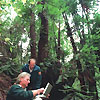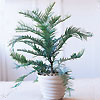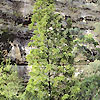 |
 |
|

Newsflash: 10 Year Anniversary of the Discovery of the Wollemi Pine Ten years ago in September 1994, the Wollemi Pine was discovered by chance by David Noble, a New South Wales National Parks ranger and avid bushwalker. David was abseiling with friends in the Wollemi National Park within the Greater Blue Mountains Area just 200km west of Sydney when he stumbled upon a striking and unusual tree. According to David, he was so taken with the sight of the Wollemi Pine that he picked a leaf off the tree and took it back home to identify it. After having little success himself he took it to a botanist at the National Parks and Wildlife Service where it was thought to be some sort of fern. His report that the sample came not from a fern but from what looked like a strange, conifer-like tree intrigued scientists, prompting David to return to the site of the Wollemi Pines with key scientists to gather more specimens and undertake research. The
trees looked like nothing any of them had ever seen before. They
were given the working title, the "Wollemi Pines". It
was named after the Wollemi National Park, the location where the
Pines were first discovered. The scientific name Wollemia nobilis
was in honour of the Pine's majestic qualities and the man who discovered
them, David Noble. For those who will be in Sydney (Australia) on September 10, the Botanic Gardens Trust (Sydney) invites you to take part in its 10 year anniversary celebrations of the Wollemi Pine. A special luncheon will be held at the Gardens Restaurant at the Mt Annan Botanic Garden with speakers including David Noble (on the tale of his discovery), Patricia Meagher from the Botanic Gardens Trust (on the latest research findings), and Sally McGeoch from Wollemi Pine International (on the propagation program). For more information, please email info@wollemipine.com. |

Behind the Scenes with Robert Humphries Robert Humphries is a wildlife ecologist who has worked with the New South Wales (NSW) and Victorian National Parks and Wildlife Services for the past 18 years. In the past 14 years, he has specialised in the management and recovery of threatened species. He is currently the Manager of the Threatened Species Unit for NSW National Parks and Wildlife Service and chairs the Wollemi Pine Recovery Team. The Wollemi Pine Recovery Team is comprised of representatives from NSW National Parks and Wildlife Services and the Royal Botanic Gardens (Sydney) who manage the implementation of the Wollemi Pine Recovery Plan. The Recovery Plan was developed in accordance with the NSW Threatened Species Conservation Act 1995 (under which the Wollemi Pine is listed as a threatened species) and was adopted by the NSW Minister for the Environment in 1999. The aim of the Recovery Plan is to protect the known wild populations of the Wollemi Pine from decline induced by non-natural sources and to ensure that they remain viable in the long term. According to Robert, the highest priority for the Wollemi Pine Recovery Team, as set out in the Recovery Plan, is to ensure the ongoing protection of the Pines in the wild. "The team sets priorities for the implementation of management and recovery actions as research data becomes available and potential threats are identified. A major focus of the team's deliberations over the past two years, has been the increasing danger to the survival of the wild Pines as information regarding their secret location has filtered into the broader community," said Robert. Given experiences with other discoveries and/or rediscoveries of endangered plant species and the insatiable appetites for some in the horticultural world to collect and grow specimens, Robert supports the opportunity of commercially propagating the Wollemi Pines and making them widely available to the general public. "Commercialisation is an important measure to reduce the demand on access to the wild Wollemi Pines. The Pines have generated an incredible amount of interest since their discovery and I am looking forward to the release of the propagated specimens," said Robert. In addition to working on the Recovery Plan for the Wollemi Pine, Robert is involved in the recovery of around 300 threatened species and endangered ecological communities across the Sydney Basin. His team of threatened species officers assist Councils in their assessment of the impact these species have through the development of control processes. Stay tuned to hear more about people like Robert who are working to conserve and protect the Wollemi Pine for current and future generations to enjoy. |

Australia Celebrates National Tree Day Australia's equivalent to Arbor Day is National Tree Day which is held every July and marks the nation's largest community tree planting day. The Organisers, Planet Ark, estimate that over 1 million native trees were planted on Tree Day on Sunday July 25 adding to the 6 million planted since the event began in 1995. This year the event motivated more than 225,000 volunteers ranging from councils, schools, environmentalists and celebrities who united in an effort to "Green up" Australia. Schools Tree Day held on July 23 aims to gain greater involvement of Australia's youngest community members. National Tree Day allows the Australian community to focus on the part that trees play in their lives and their future as well as actively participating in helping to protect and rehabilitate our unique environment. Arbor Days/Tree Days are now recognised in more than 50 countries, according to Australia's Department of Conservation and Land Management (CALM). Whether it be called, Greening Week in Japan, Tag des Baumes in Germany or be it Tree Loving Week in Korea, it allows individual communities to work together to take part in the "Greening up" of the world. The Wollemi Pine will no doubt become an important symbol of Tree Days in both Australia and internationally when it is released at the end of 2005. By planting the Wollemi Pine people will not only be contributing to rehabilitating the environmental but also repopulating an endangered species and ensuring the Wollemi Pine's long term survival. For
more on National Tree Day
|

Wollemi Pine Conservation Club: Where Can I Grow a Wollemi Pine? One of the most commonly asked questions from Wollemi Pine Conservation Club members is where people can grow a Wollemi Pine. Here is a response from Kate Murray who is the Project Officer at the nursery growing the Wollemi Pines in Australia. We are delighted with the versatility and hardiness of the Wollemi Pine. Not only are they very beautiful and striking in appearance, but we have found them easy to grow, drought hardy and pest and disease resilient. We believe that the Wollemi Pine will grow in a wide range of locations, from outdoors in the full sun to indoors in air-conditioning, and in a wide range of climatic regions. The Wollemi Pine will make an excellent plant for homes, gardens and parks throughout the world. We already know that the Wollemi Pine will survive a range of temperatures from -5 °C to 45 °C (23 °F to 113 °F) and we think it could even be hardier than this. Not only has it survived through ice ages and many millions of years, but Wollemi Pine relatives such as the Monkey Puzzle, Hoop and Bunya Pines grow in climatic conditions ranging from freezing to very warm and humid. We are currently running trials that will test the Wollemi Pine in a range of extreme climatic conditions. The native habitat for the Wollemi Pine is a sandstone canyon in a ferny, warm temperate rainforest. The soil has poor structure and is very shallow. The levels of nutrients are low, the soil is extremely acidic and there are patches of highly saline soil. The light level is very low, with less than 10% ambient light. As these conditions would be inhospitable for most plant species, we believe that the Wollemi Pine would be very tolerant of a wide range of growth conditions. Extensive trials have shown that Wollemi Pines adapt well to growth in low light environments (e.g. in a home or office) to high light (including the full sun). The Wollemi Pine's root growth is strong, but not so vigorous that plants will require frequent re-potting or will be invasive in the garden. They can also be maintained in a container almost indefinitely which is great news for those who do not have the space to plant a Wollemi Pine in their garden. In optimal conditions, the growth rate for the Pine is approximately 0.5 metres per year for smaller sizes, and 1.5 metres per year for larger sizes. The Wollemi Pine responds well to fertiliser and can be pruned and shaped at any time of the year to become bushier. They are strong plants with flexible stems and leaves that are not easily damaged, so we also expect them to be wind tolerant. Preliminary results indicate that they are also relatively salt tolerant, and could be planted by the ocean, just like other members of the family e.g. Norfolk Island Pine. Many people mistakenly think the Wollemi Pine looks like a traditional pine tree with needles. This is not the case. It is a beautiful conifer with unusual dark green, soft frond-like foliage. The tree produces three different types of foliage, depending on age and position in the tree. In general, the narrow triangular leaves are arranged in two opposite ranks. The new foliage is a fresh apple-green colour and deceptively delicate looking. The older blue-green foliage contrasts vividly with the new foliage, providing a structural and textural backdrop to any environment. The Pines have an unusual and interesting growth habit that will make growing your Wollemi a daily journey of discovery. For instance, during colder weather, the Wollemi Pine enters a dormant mode in which each of the growing buds develops an attractive pink waxy coating. The bark is also unique and in the mature plants, it resembles bubbling chocolate. We
believe the best uses for the Wollemi Pine will be as a perfect
indoor and patio plant, unique gift and great feature tree for large
gardens and parks. We are planning to have a range of product available
from small pot plants that will be about 4-6 months old to large
trees that are up to 3m and 6-7 years old. The first release of
Wollemi Pines will be available from the end of 2005, so stay tuned
for more updates. See
more frequently asked questions Joining the Wollemi Pine Conservation Club registers your interest in purchasing a Wollemi Pine when they are released in 2005/6. |

* Trees first appeared on earth long before the dinosaurs did -
about 400 million years ago. Want to experience the Wollemi Wilderness? Download your own Wollemi wallpaper >> Click Here |
| Photos:
Jaime Plaza (Botanic Gardens Trust), Planet Ark and Blue Mountains Tourism |
